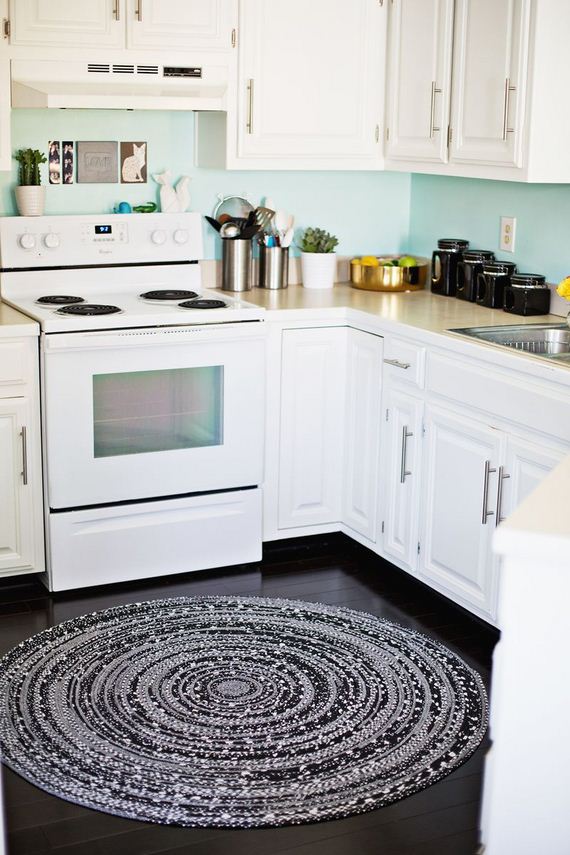
Soooo, remember when I shared this woven rag rug tutorial with you and I gave my solemn vow to hunt down other good rug projects? Well, I can hold my head up high because as of today I have kept that promise. No applause, please. You’re all welcome. Take a look at what some rope and fabric strips can become!
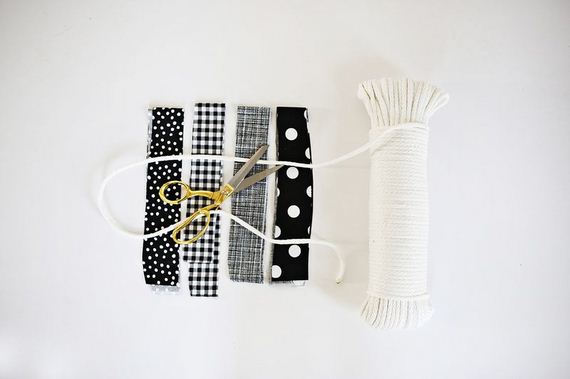
Supplies:
– 1/4″ clothesline (I used three of this brand)
– fabric scissors
– fabric cut into 2″ wide strips (I used four different patterns and 9 yards of total fabric)
– standard sewing machine
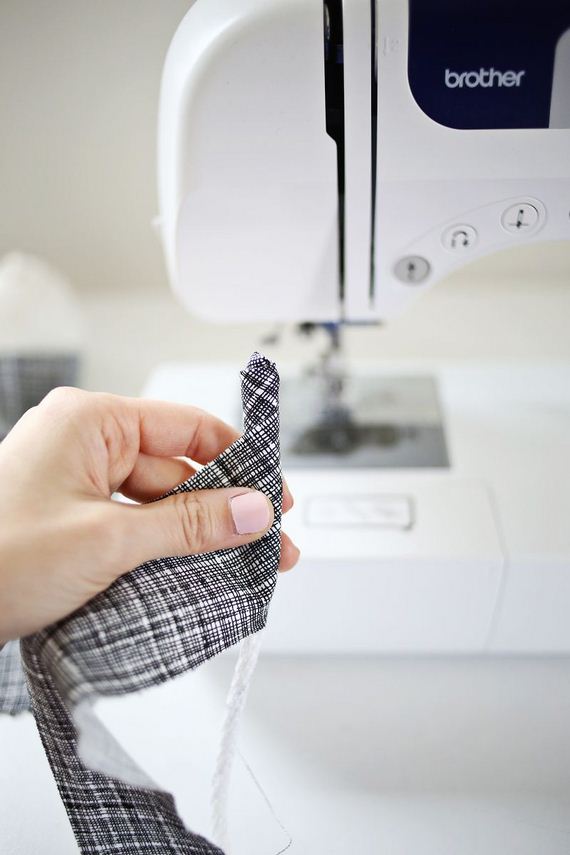
Take the beginning of your rope and wrap the end with one of your fabric strips. There’s no special way that you need to wrap the end; just make sure the tip is covered with the fabric, and then start to wrap the fabric from either right to left or left to right (depending on which is more comfortable for you if you’re right- or left-handed). Use your sewing machine to sew straight down the rope a few inches to hold the wrapped end in place. I would suggest using a heavy needle, like a jean needle, since you are sewing the rope as well as the fabric.
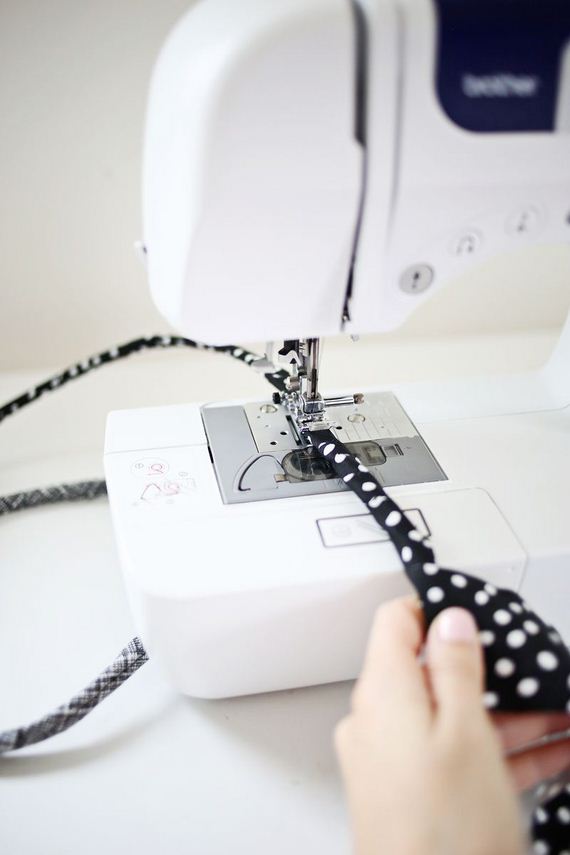
Keeping your machine needle in the rope, continue to wrap the rope with the strip at a slight angle so you are continuing down the rope (instead of just wrapping the same spot). Once you get a foot or so of wrapped rope, sew straight down the middle of the rope until you reach the end of your wrapped rope (I put my sewing machine on the longest stitch length). Continue this process until you have 10-15′ of wrapped and sewn rope.
I switched my fabric every time I got to the end of a strip and alternated between my different patterns. Just wrap the beginning of the new strip overtop of where the old strip ends so the rope never shows through. Try and switch up the pattern rotation every so often to keep the patterns looking random overall. When you get to the end of a pack of rope, just place the beginning of a new rope right after the end of the old rope and wrap around them as you normally would. Once you sew straight down that spot, it will join them together.
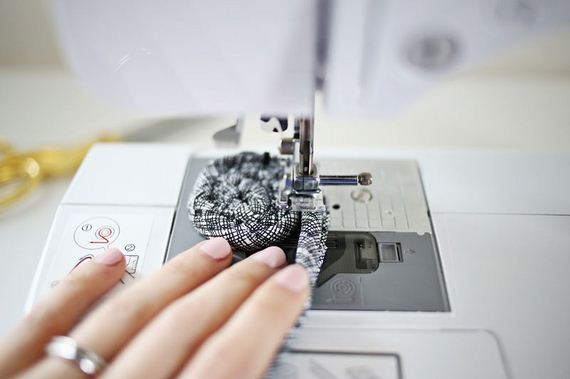
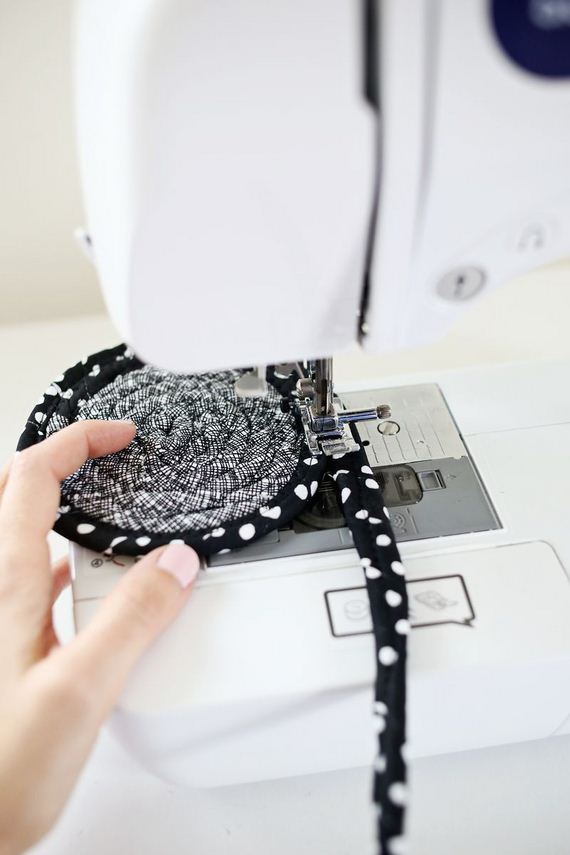
Take the beginning end of your wrapped and sewn rope, and make a small clockwise coil. Once you coil a complete circle, use a medium to long stitch length and the widest zigzag setting to sew between the ropes and join them together. Keep turning the coil and joining new rope to the coil until you reach the end of your sewn and wrapped rope. Once you reach the end, continue the process of wrapping and sewing straight down the rope until you get another 10-15′ sewn, and then zigzag stitch that rope onto your coil. And you know what? That’s pretty much it. You just do that over and over and over until the rug is as big as you want it to be. To keep the sides from curling up as you go, try not to pull on the rope you’re joining to your rug. Just lay the rope next to the coil as you sew without either pushing or pulling on it.
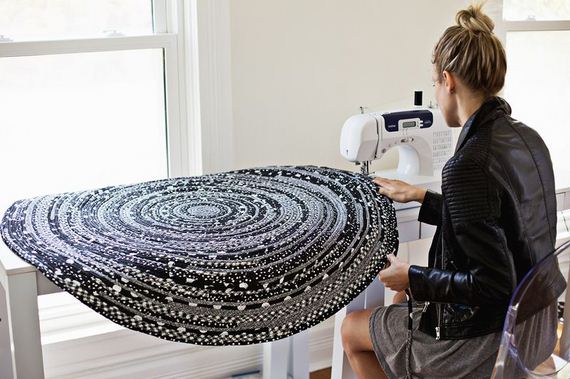
Once the rug gets to be too big for the table your sewing machine is on, you’ll need to add another side table or desk next to your sewing machine to keep the rug flat and even with the sewing machine platform at all times (this really helps it not curve up like a giant bowl). I had to add a few books, etc., under the legs of the second table to make it the right height.
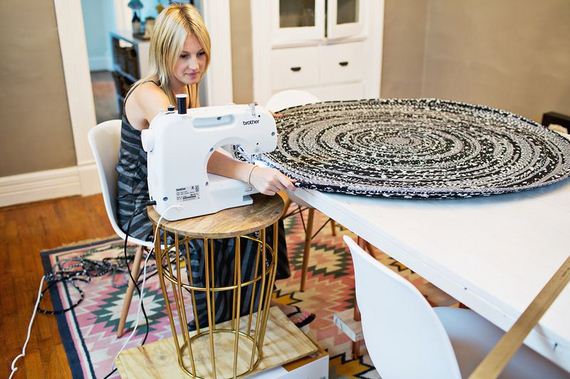
Once it got too big for the desk, I moved it to the dining table and finished the process there. You can see I took a side table and put a box under it to make it the right height. Definitely a makeshift solution, but it worked! When I was done with the rug, I did still have some slight waves that wouldn’t lie flat. To fix those, I placed the rug on top of a carpet, gave the rug a good spray of water with a spray bottle, and ironed the rug with my iron on the highest steam setting. Once it felt damp with steam, I put some heavy books on the trouble areas and allowed the rug to dry. Goodbye, waves! I will say, though, if you feel the edges are getting too curled while you’re sewing, it’s best to just use a seam ripper and rip those rows out and resew them while not pulling so tight. I had to do it a few times, but it was worth it in the end. If you’re not sure if it’s getting too wavy, you can do the steam/iron trick before the rug is finished, and if the waves disappear, then you’re good; if not, you probably need to redo those rows.
To finish the rug, use your fabric strip to wrap your end of the rope similar to how you wrapped the rope at the beginning of the rug (just make sure the end of the rope is covered), and sew down the middle to secure. Using the zigzag stitch, tuck the end of the rope under your rug so it disappears from sight, and sew over it to secure.
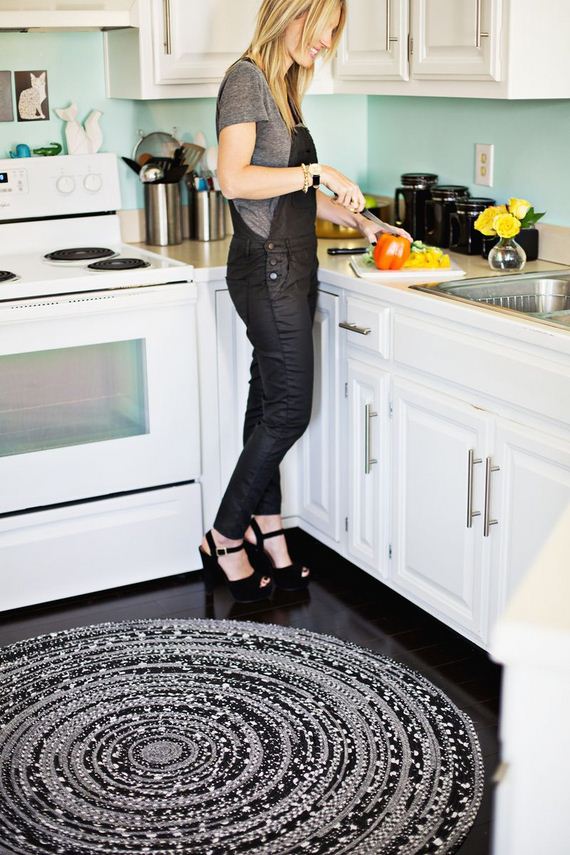
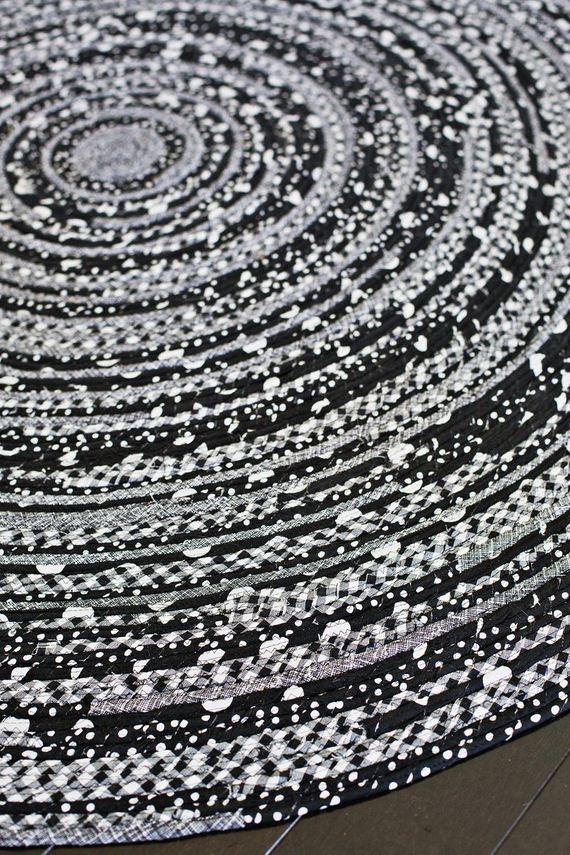
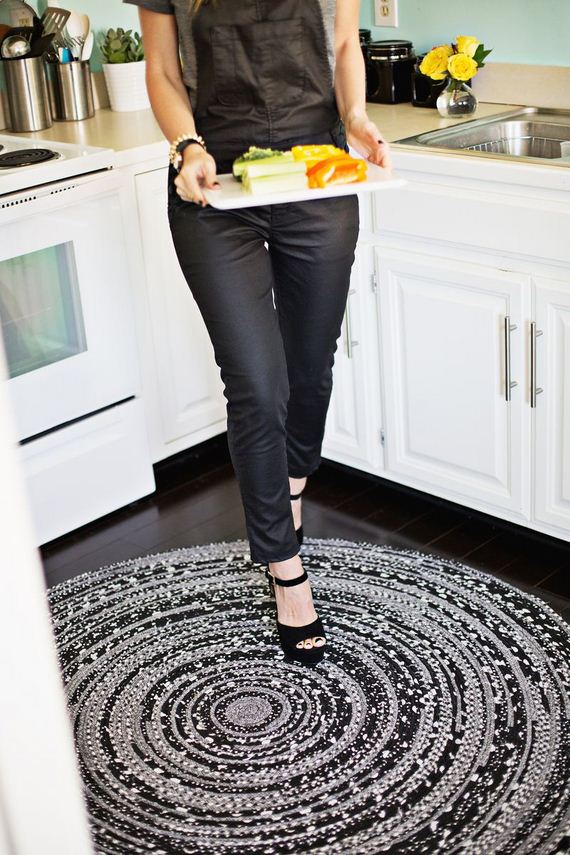
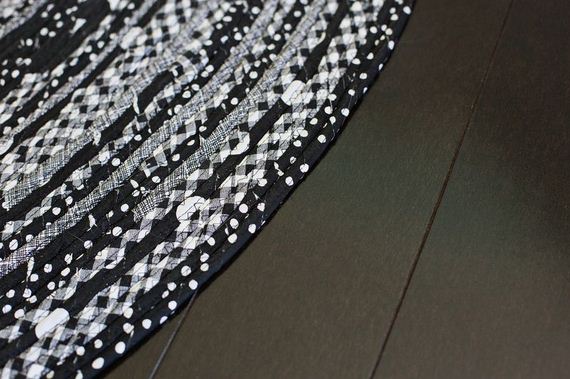
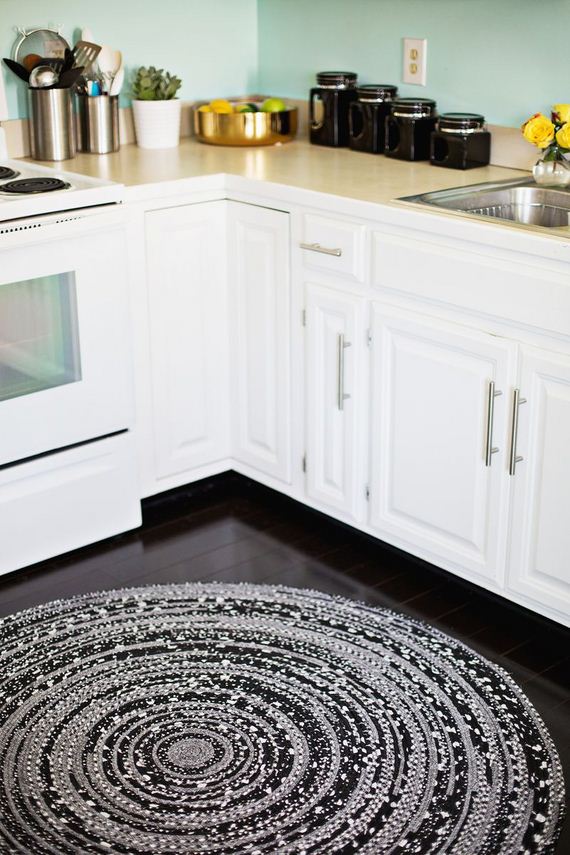
As you can see, I ended up with a rather sizable rug (55″ wide!). I’m actually considering continuing the rug and seeing just how big I can make it, but until I get that second wind of rug sewing strength, it’s going to hang out and look cute in our kitchen.
In case you’re wondering how long a rug like this takes, well, it all depends on how big you want to make it. It grows bigger much faster in the beginning because it doesn’t take much time to go all the way around the small coil, but the pace slows as the coil gets bigger. Thankfully, our world-class intern Alex helped me with some of the prep work so we could get this rug finished and ready to share with you as fast as possible—thanks, Alex! Just to give you an idea on how much time it takes, it took us 6 hours to make a 30″ rug, 10 hours to make a 38″ rug, 14 hours to make a 47″ rug, and 17 hours to make a 55″ rug.
Overall, I’m so happy with how this rug turned out. This is definitely a project that you come back to a few times rather than a one-day ordeal (especially if you want a bigger rug), but it’s totally worth it in my book. Go get yourself some rope and cute fabric, and get sewing! xo. Laura
 12thBlog Hot Celebrity Photos
12thBlog Hot Celebrity Photos